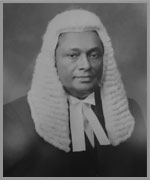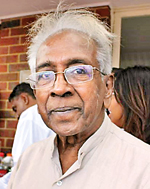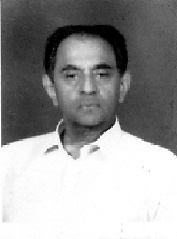A commentary
by Sachi Sri Kantha
The Sinhalese word ‘Deshamanya’ literally means ‘Pride of the Nation’, awarded since 1986 for ‘highly meritorious service’. According to the Wikipedia listing, between 1986 and 2025, a total of 119 individuals have been decorated with this tag. [https://en.wikipedia.org/wiki/Deshamanya, accessed Feb 6, 2025] Among these 119, only 18 have been Tamils of indigenous origin and recent Indian origin.
As I left Sri Lanka in 1981, I never bothered much about the awards in Sri Lanka which were established after this year. But, I do note that I had received one island-wide award (Sri Lanka Sahitya Award for authoring a Tamil book on Karnatic music, published in 1977, after I left Sri Lanka; this award was announced in 1982, back-dated to 1977). At that time, the cash remuneration was 1,000 Sri Lankan rupees and an award certificate.
This ‘Deshamanya’ award recently captured my attention last month, when I read a raspy note by journalist Rajpal Abeynayake, commenting about the death of former Attorney General of Sri Lanka, Siva(kumaran) Pasupathy in Australia, at the age of 96.
Rajpal Abeynayake’s Vitriol

Siva Pasupati
I read the rant of Rajpal Abeynayake (who had promoted himself to the New York Times, as the Rush Limbaugh of Sri Lanka) in Tuppahi’s blog site, maintained by Prof. Michael Roberts.
https://thuppahis.com/2025/01/22/rip-victor-ivan-jvp-reporter-stirrer/#comments
The original version appeared in the Colombo Daily News of Jan 20, 2025.
The relevant excerpts to Mr. Siva Pasupathi follows:
“Shiva Pasupathi was the Attorney General of Sri Lanka for over ten years, including the years in which hostilities broke out between the military and the armed LTTE in the early 80s. Having served as the longest serving AG since the creation of the post over 150 years back, Pasupathi retired, and was accorded the honour of Deshamanya.
However, then came a slow descent into the most reprehensible conduct you’d expect from any government servant, leave alone someone who had earned the title of Deshamanya. Pasupathi migrated to Australia, and became the Chief legal advisor to the LTTE, banned for its terrorism in many parts of the world.
The Bar Association of Sri Lanka [BASL] in what should be one of its most ill-considered recent missteps, announced this week to its membership that a former AG and Deshamanya had passed away in Australia. The passing should have received no mention at all. Pasupathi died a traitor to his country of birth, having held one of the highest positions in the land irrespective of the fact that he belonged to the minority Tamil community. That’s of course how it should have been and how it was in Sri Lanka, despite the war that was waged by the LTTE for a separate State. But none of that stopped him from becoming the LTTE’s chief legal advisor, when this banned organisation waged a brutal campaign of terror against this country, wreaking havoc, killing our leaders, killing innocent children in the border villages, bombing and maiming innocent civilians by the thousands, and killing even leaders of neighbouring countries, such as Rajiv Gandhi, former Prime Minister of India.
No, the BASL should not have mentioned his name at all. Let them bury him in Australia. There wasn’t a single more malign force among lawyers that advanced the cause of terror and subversion in this country, than Shiva Pasupathi. He tried to give legal impetus to the LTTE despite its terrorist activities, gunrunning, drug running and myriad other endevours designed to wreak havoc in his mother country. All he succeeded in, however, was getting the organisation banned in 30 countries. A local commentator said Pasupathi was not the most ruthless in the LTTE, but certainly was its most disgusting, considering that he nonchalantly betrayed his country that he served in one of its highest capacities. If he had an ounce of self-respect, the man would have renounced his Deshamanya title, but he didn’t. To make mention of him as a Deshamanya today is a travesty perhaps equal to calling Prabhakaran a national treasure. Perhaps the Bar Association should apologise.”
My comment on Rajpal’s vitriol
I sent my comment to Prof. Michael Roberts, and he had kindly posted it in his Tuppahi’s blog. For this, I’m thankful to him. My rebuttal was as follows
“Rajpal’s raspy comments on Shiva Pasupathy deserves a note, from a Tamil. I do understand that Mr. Abeynaike, being an ardent Sinhalese nationalist, is entitled to his cock-eyed view.
It would have been somewhat illustrating, if he had mentioned a reason, why Shiva Pasupathy was decorated by Deshamanya award. In 1976, under Sirimavo B., as the Attorney General, he prosecuted A. Amirthalingam, and three of his Federal Party Colleagues (K.P. Ratnam, V.N. Navaratnam and K. Thurairatnam) who were then in the parliament in a Trial at Bar case.
It is a fact that Mr. Pasupathy subsequently became a legal advisor to LTTE. Rajpal’s raspy comment was ‘All he succeeded in, however, was getting the organization banned in 30 countries.’ So what? Rajpal should NOT forget that in this globe, there are nearly 200 countries/territories. Can I infer that Pasupathy’s mission was a success arithmetically, in that nearly 170 countriesterritories did NOT consider LTTE as a terrorist organization. Those 30-odd countries had their own different reasons to be antagonistic to LTTE, not because LTTE offered danger or instability to their own territory.’
The complete list of ‘Deshamanya’- tagged Tamils [as of now]
Below is a list of 18 ‘Deshamanya’ –tagged Tamils, until 2019. Unfortunately, for a few of them, I couldn’t find their date of birth and/or date of death (if they are not among the living) in the open sources I checked online or in published print sources.
1987
Vaithialingam Manicavasagar (1906 – 1993) – Supreme Court Justice, Chancellor of University of Jaffna.
1988
Thambiah Sivagnanam (? – ?) – Deputy Controller of Prices
1989
Siva(kumaran) Pasupathi (1928-2025) – Solicitor General, Attorney General.
1990
Balakumaran (Baku) Mahadeva (1921 – 2013) – civil administrator
1991
Kanapathipillai William Devanayagam (1910 – 2002) – lawyer, UNP party politician, cabinet minister.
Chandirapal Chanmugam (? – ?) – Secretary of Treasury, ex-Member of Monetary Board.
1992
Suppiah Sharvananda (1923 – 2007) – 37th Chief Justice, Provincial governor
1993
Henry Wijeyakone Tambiah (1906 – 1997) – Supreme Court Justice, academic, author.
Ponna Wignaraja (1926 – ?) – academic, economist affiliated to World Bank for most of his career.

A.Y.S. Gnanam
1994
Arulanandam Yesuadian Samuel (A.Y.S.) Gnanam (1922 – 2007) business tycoon, Head of St. Anthony’s Group of companies
Surendra Ramachandran (1934 – 2010) – physician, nephrologist
1998
Kandiah (Ken) Balendra (1940 – ) businessman
2005
Radhika Coomaraswamy (1953 – ) law academic, served a term as the Under-Secretary General at UN.
Pathmanathan Ramanathan (1932 – 2006) Supreme Court Justice, 4th governor of Western Province.
Mano Selvanathan (? – ) Group Director, Carson Cumberbatch Company
2008

Devanesan Nesiah
Ramesh Mahendran (? – ) not much information available.
2017
Dr. Devanesan Nesiah (? – ) civil administrator, academic.
2019
Indrajit Coomaraswamy (1950 – ) economist.
My Critical Observations
My critical observations, based on the details presented in the Wikipedia entry Deshamanya, are as follows:
The above list is top heavy with individuals who are affiliated with law (Justices, one Attorney General and a couple of academics, n = 6) and successful businessmen (n = 4). Even among the chosen Deshamanya-tagged businessmen, not all are household names. The most visible, household name among the Tamils was Mr. A.Y.S. Gnanam. He was an Indian Tamil ethnic, and a naturalized Sri Lankan Tamil. Another businessman among Deshamanya–tagged Tamils was Mano Selvanathan, a grandson of an Indian Tamil immigrant.

Ponna Wignaraja,
Few economists (n = 3) can be recognized. But, among the 18 Tamils, I recognize only two (Henry W. Tambiah and Ponna Wignaraja) for authentic scholarly contributions. I will place two more (Radhika Coomaraswamy and Devanesan Nesiah), as quasi scholars, as they earned PhDs from top ranked universities. Only one politician (K.W. Devanayagam) prevailed in the choice of Deshamanya of Tamil origin. But, he was associated with the UNP, and represented Kalkudah constituency as an MP and Cabinet minister, from 1965 to 1988. This itself indicates a covert anti-Tamil bias among the selectors. And only one medical doctor!
Also to be noted is the blaring omission of any scientist, an artist, a literateur among the Tamil ethnics for selection as Deshamanya. The unwritten rule for selection is that, all the Deshamanya tag holders should show overt and covert sensibilities to the majority community’s needs and deeds, until their death. If any step out of this boundary, they will be castigated as un-patriotic, as had happened in the case of Siva Pasupathy. Few years ago, this happened to Devanesan Nesiah as well. He was awarded Deshamanya title on March 20, 2017. In the following year, answering his conscience, Nesiah returned the honor on November 7, 2018. The reaction from Sinhalese natives to this sort of act was, as predictable.
I reproduce two comments posted in Tuppahi’s blog in 2019 and 2023. Be warned that the handle names of correspondents are NOT a precise indicator to the ethnic identity. Many such correspondents are cowards, who don’t have the courage to identify themselves openly. I have NOT corrected the sentences for grammar and spelling. The one with the handle name Dickie Bird was written in 2019,
“what has politics got to do with a national honours conferred on Devanesan Nesiah ?
It was not the President who honoured Mr. Nesiah, but it was the President on behalf of the Country. If it not Mr. Nesiah, someone else would have filled the post of GA Jaffna then.
Mr. Nesiah must realise principles of people differ from one to another just like finger prints.
Therefore, I begin to wonder what the ulterior motive for this so called outstanding Servant of the State to return the ‘Dheshamanya award’ that was conferred on him by the Country?
Its hard for me to accept his actions as it has not changed anything in the Country. Robbers are the Rulers and he Mr. Nesiah in the first place had accepted the honour from them itself.”
The second one with the handle name, ‘Chelvy’ had written in 2023,
“He doesn’t deserve such award because he is one of the person who ran out of the country to USA and didn’t complete his service. He is a selfish self-centered person only cared about his family only. There are many peope who worked hard and never left that country. That award should go to them.”
Now, I criticize the thoughts of correspondent ‘Dickie Bird’. Despite his handle name (which originally belongs to a well-recognized cricket umpire from England, born in 1933), he is a Sinhalese. He was totally wrong in asserting, “what has politics got to do with a national honours conferred on Devanesan Nesiah ?
It was not the President who honoured Mr. Nesiah, but it was the President on behalf of the Country.” Deshamanya awards given by the President of Sri Lanka were/are are politically expedient crumps delivered to doddering folks, who had achieved some sort of national recognition in their passage of life. The President of the island, simply shares the limelight of reflected glory. Here are a few essentials about this award.
- It was NOT an annual award, like the Nobel prizes. Most notably no awards were given from 1999 to 2004, from 2009 to 2016 and from 2020 to 2024.
- The number of recipients are NOT limited to one or a few. The maximum limit for Nobel prizes for individuals is three. There were 14 Deshamanya awardees in 1998, and one of these was a posthumous award to Abraham T. Kovoor, who had died in 1978. And for the year 2005, there were 32 Deshamanya awardees.
- The jury for the selection committee is mysterious and remains a state secret. Is the selector only one individual (i.e., the President)?
- There were no Tamils in the 1986 list of Deshamanyas, consisting of 6 individuals. In the following year, 1987, there was one – Supreme Court Justice V. Manickavasagar, who happened to a neighbor of the then President J.R. Jayewardene, and in the same age cohort of Jayewardene! I’m pretty sure that this particular selection of Manickavasagar was a politically expedient one, because it was publicly known that Jayewardene had promoted him as a ‘pliant Tamil leader in politics’, opposed to A. Amirthalingam, the then nominal leader of parliamentary politics.
Finally, I can identify six Tamils of Deshamanya award caliber (who were living after this award system was initiated in 1986), but were omitted from this honor for identifiable reasons. These six were:
James Thevasan Rutnam (1905 – 1988) – politician and Tamil scholar
Kanagasabai Gunaratnam (1917-1989) – movie mogul and businessman
Prof. Christie Jayaratnam Eliezer (1918 – 2001) – mathematician cum physicist
Dr. Siva Chinnatamby (1923 – 2000) – obstetrician and fertility specialist
Prof. Supramaniam Vithiananthan (1924 – 1989) – Tamil professor
Ponnuthurai aka Es Po (1932-2014) – Tamil author
Excluding Es Po, previously I had written about the works/services/societal contributions of first five in this site. About Es Po, whom I came know personally, I will contribute one, at the earliest.
In my evaluation, anything to do with pro-Tamil activism has remained a distinct bar for this Deshamanya award. Es Po’s one son was a LTTE’s martyred hero. Prof Eliezer overtly identified himself with the LTTE during the last decade of his life in Australia. Prof. Vithiananthan and James Rutnam also identified themselves strongly with the Tamil cultural revival activities, especially during the Fourth International Tamil Research Conference held in Jaffna (1974), despite strong objections from the Sri Lankan government circles. Dr. Siva Chinnatamby was targeted for criticism by Buddhist prelate Ven Maddihe Pannasiha Thero (1913-2003), for her professional activities on family planning. Those interested, can check my posted commentary [https://sangam.org/dr-siva-chinnatamby-20-years-after-her-death/] In addition, she was also a close kin of M. Sivasithamparam, the President of TULF (1977-2002).
Movie mogul K. Gunaratnam, though openly supportive to Sinhalese ethnics in the development of the Sinhala movie industry by sponsoring directors from 1953 to 1978, was envied by them and was despicably assassinated by JVP activists in 1989.
On the assassination of Mr. K. Gunaratnam
In my Sept 2014 tribute to Mr. Gunaratnam, for lack of information, I had omitted his assassination by the JVP activists. [https://sangam.org/kanagasabai-k-gunaratnam-1917-1989/]. For that tribute, I had missed a clipping of an item lying in my files. This was a commentary by Tom Marks, which had appeared in the Wall Street Journal of Aug 16, 1989, page A-13. This was a week after Mr. Gunaratnam’s assassination on Aug 9, 1989. Tom Marks had been profiled as, ‘a former U.S. military intelligence officer, who specialized in revolutionary warfare, has traveled extensively in Sri Lanka since 1983.’ Three paragraphs from this commentary by Marks on JVP insurgency in 1989 (though somewhat tangential to Gunaratnam assassination), are excerpted below:
“the JVP has learned a great deal from its earlier lack of success in 1971 when a popular explosion placed the survival of the government in question but was crushed when it moved too far ahead of its popular base. Previously sympathetic to the Tamil cause, the JVP flip-flopped and adopted a hard-line pro-Sinhalese stand when it became clear that it was to its advantage. This served it in good stead when the Indians entered the picture, because it allowed the party to wrap itself in the mantle of nationalism. Indeed, JVP documents say virtually nothing of its ideological stance, instead concentrating on the betrayal of the country by its rulers. It is but a logical next step to advance a simple connection: The same people who sold you out are responsible for the poor conditions of life in which you find yourselves. Yet this linkage is so far reserved for instructions to JVP cadres.
Meanwhile, the insurgency gains strength. Whole areas of the countryside have effectively become ‘no-go’ areas, and urban unrest has grown dramatically. Anonymous ‘struggle committees’ now function in virtually all businesses and close them down at will by simply posting notices instructing work to cease lest reprisals be taken. By killing prominent people who do not comply with their demands, the insurgents have gained authority far beyond their numbers. The industrial sector functions at what appears to be just 20% capacity.
Such economic paralysis, in turn, feeds the JVP cause. Already, many businesses report they are unable to meet their loan and tax obligations, concentrating only on at least paying their workers. As this, too, becomes impossible, the ranks of the unemployed will provide fertile ground for JVP recruiters….”
According to a brief report that appeared in the Lanka Guardian of (Sept. 1, 1989, p. 6),
“Parliamentary Affairs and Justice Minister Vincent Perera told Parliament that 841 persons had been killed between July 16 and August 18, 1989.” Mr. Gunaratnam’s assassination was one of 841.
So here are my seven questions, which wait for answers – after 35 years and counting. (1) Why was Mr. Gunaratnam assassinated bythe JVP? (2) Who made such a decision? (3) Was it Rohana Wijeweera? (4) What sort of specific grudge had Wijeweera on Mr. Gunaratnam, other than the general version presented by Tom Marks? (5) Were there ‘struggle committees’ (as tagged by Tom Marks above) in the businesses owned by Mr. Gunaratnam? (6) If so, identities of the JVP member(s) belonging to such ‘struggle committees’ should be available, right? (7) Was any serious attempt been made to identify the assassins by the law enforcement folks?
My tentative inference is Mr Gunaratnam was killed for being a very prominent, successful Tamil businessman (an unarmed soft target) to protest against the presence of IPKF in the North-East provinces, for the reason that he had ‘disobeyed’ the orders of so-called JVP’s ‘struggle committees’. Now that JVPers are holding the wheels of power in Colombo, will the current leadership of Anura Kumara Dissanayake (b. 1968, was living underground in 1989 to avoid detection from government law enforcement arm) take any deserving actions?
****